Mega Archive: Part XXVI: From Teenage Mutant Ninja Turtles to Ex-Mutants
By Mento 0 Comments
Welcome back to the Mega Archive, a chronological exploration of the Sega Mega Drive/Genesis, as it inches ever closer to the end of 1992 and the conclusion of a banner year for Sega's 16-bit champ. Have to admit, now that the western developers have all but taken over, it's become a lot less... I suppose "mysterious" is the word I'm looking for here. When I researched the SNES/SFC in a similar fashion, its sheer volume of Japan-exclusive content made every new month a wonderland of weirdness (even if that "weirdness" was often just limited to pachi-slot sims). The Mega Drive didn't quite enjoy the same level of third-party support in its native land - though there's plenty to be said for quality over quantity - and so most of what I catalogue here tends to be familiar multiplatform games: either those the Genesis shares with the SNES and other contemporary consoles or Amiga/Atari ST conversions. Fun to revisit for sure, but mostly well-trodden territory. We'll have one more episode each of Mega Archive and Mega Archive CD to finish off 1992, and then it's time for a very long break I think.
We had one hell of a line-up on the last Mega Archive with the likes of Streets of Rage 2 and Ecco the Dolphin, so it's only fair that this week is mostly whammies. Well, that's not entirely accurate: we do have a decent Amiga racing game, an excellent cartoon brawler, a beloved Disney platformer, an EA-Sega mainstay liked well enough to make it onto the Sega Genesis Classic, and even a cameo from an old Giant Bomb favorite.
Before we get started, here's a quick (?) recap of where we've been:
| Part I: 001-020 (Oct '88 - Dec '89) | Part XI: 161-175 (Jul '91 - Aug '91) | Part XXI: 311-320 (Sep '92 - Oct '92) |
| Part II: 021-035 (Dec '89 - Mar '90) | Part XII: 176-190 (Aug '91 - Sep '91) | Part XXII: 321-330 (Oct '92) |
| Part III: 036-050 (Apr '90 - Jul '90) | Part XIII: 191-205 (Oct '91 - Nov '91) | Part XXIII: 331-340 (Oct '92 - Nov '92) |
| Part IV: 051-065 (Aug '90 - Oct '90) | Part XIV: 206-220 (Nov '91) | Part XXIV: 341-350 (Nov '92 - Dec '92) |
| Part V: 066-080 (Oct '90 - Dec '90) | Part XV: 221-240 (Dec '91) | Part XXV: 351-360 (Dec '92) |
| Part VI: 081-098 (Dec '90) | Part XVI: 241-255 (Jan '92 - Feb '92) | Part XXVI: 361-370 (Dec '92) |
| Part VII: 099-115 (Jan '91 - Mar '91) | Part XVII: 256-270 (Mar '92 - Apr '92) | |
| Part VIII: 116-130 (Mar '91 - Apr '91) | Part XVIII: 271-285 (Apr '92 - Jun '92) | |
| Part IX: 131-145 (May '91 - Jun '91) | Part XIX: 286-300 (Jul '92 - Aug '92) | |
| Part X: 146-160 (Jun '91 - Jul '91) | Part XX: 301-310 (Aug '92 - Sep '92) |
Part XXVI: 361-370 (December '92)
361: Teenage Mutant Ninja Turtles: The Hyperstone Heist
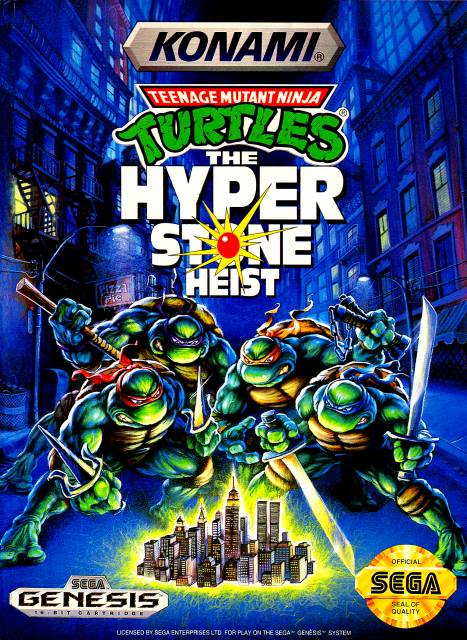
- Developer: Konami
- Publisher: Konami
- JP Release: 1992-12-22
- NA Release: December 1992
- EU Release: April 1993
- Franchise: Teenage Mutant Ninja Turtles
- Genre: Brawler
- Theme: Heroes in a Half-Port
- Premise: Shredder has shrunk down Manhattan and it's up to the Turtles to turn everything back from pint-sized to Queens-sized.
- Availability: No rereleases, though its sibling Turtles in Time was "re-shelled" semi-successfully for 360 and PS3.
- Preservation: Wild it's taken this long for a Turtles game to show up, huh? Eastman and Laird's culturally-confused foursome of Japanese-trained, Italian-named amphibians became a major hit when they were adapted into a 1987 animated show. Before then of course it was an underground Indie comic that was considerably darker and more violent, and it perhaps surprises no-one that the first Genesis game based on the franchise leans more into their edgy origin than the beloved syndicated cartoon. While the game is clearly based on Turtles in Time - the second arcade game though the fourth in the overall chronology of game adaptations - enough liberties have been taken to justify calling it a wholly original entry, with a new arrangement of bosses and levels and its aforementioned divergent graphical style. I've no idea what people think of Hyperstone Heist's place in the overall TMNT video game pantheon this many years later, except that Turtles in Time was brought back and Hyperstone wasn't so maybe that says enough (part of me thinks it's wiser to stay out of it in case this is some anicent ongoing Aladdin-like "which system had the best game?" imbroglio).
362: Toxic Crusaders
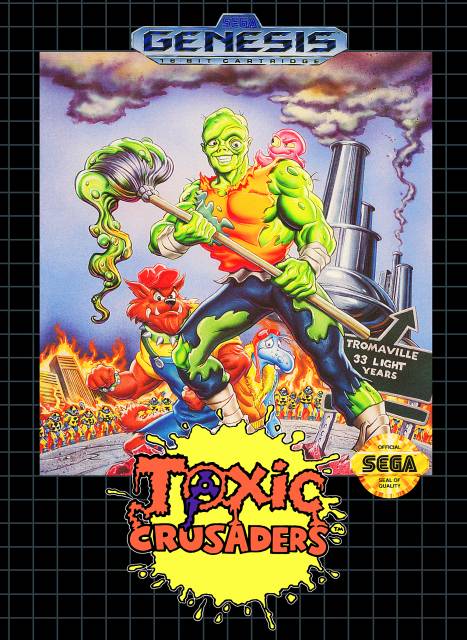
- Developer: Infogrames
- Publisher: Sega
- JP Release: N/A
- NA Release: December 1992
- EU Release: N/A
- Franchise: Toxic Crusaders
- Genre: Brawler
- Theme: Sanitizing Troma for the Childrens
- Premise: Toxie and the gang have to clean up the mean streets of Tromaville by hitting bad guys with mops.
- Availability: Nope.
- Preservation: Whenever I get nostalgic for the cartoons of my youth, especially when I'm in a combative enough mood to compare them to the cartoons of today, I'm reminded of just how sweaty the desperation was to sell toys that many kids of the late '80s and early '90s were introduced to movie properties they weren't anywhere close to the right age to enjoy. Toxic Crusaders, one of many cartoons of the '90s to embrace environmentalist themes, was based on the Troma property The Toxic Avenger, which had considerably more murder, sexual assault, and child endangerment (and that's putting it mildly) than anyone should be comfortable with at any age - Troma being something of an icon for edgy, gross-out horror comedy. The Crusaders, meanwhile, had the occasional "grown-up joke" but didn't quite wade the same irradiated waters and mostly just beat up unscrupulous nuclear plant technicians trying to hide toxic waste barrels in the park and then told kids to recycle. (Also, Colonel Campbell was in this show? He played the blue guy with the big nose. Huh.) The game's nothing special: a run-of-the-mill brawler with some awkward fast-moving skateboarding sections that see you constantly getting hit by cars. It made an effort to give each of its characters a level befitting their abilities though; for example Junkyard, a hobo that was genetically combined with a dog, has a grappling hook tongue that gets a lot of use in his part of the game (to swing across gaps with, sickos).
363: Road Rash II
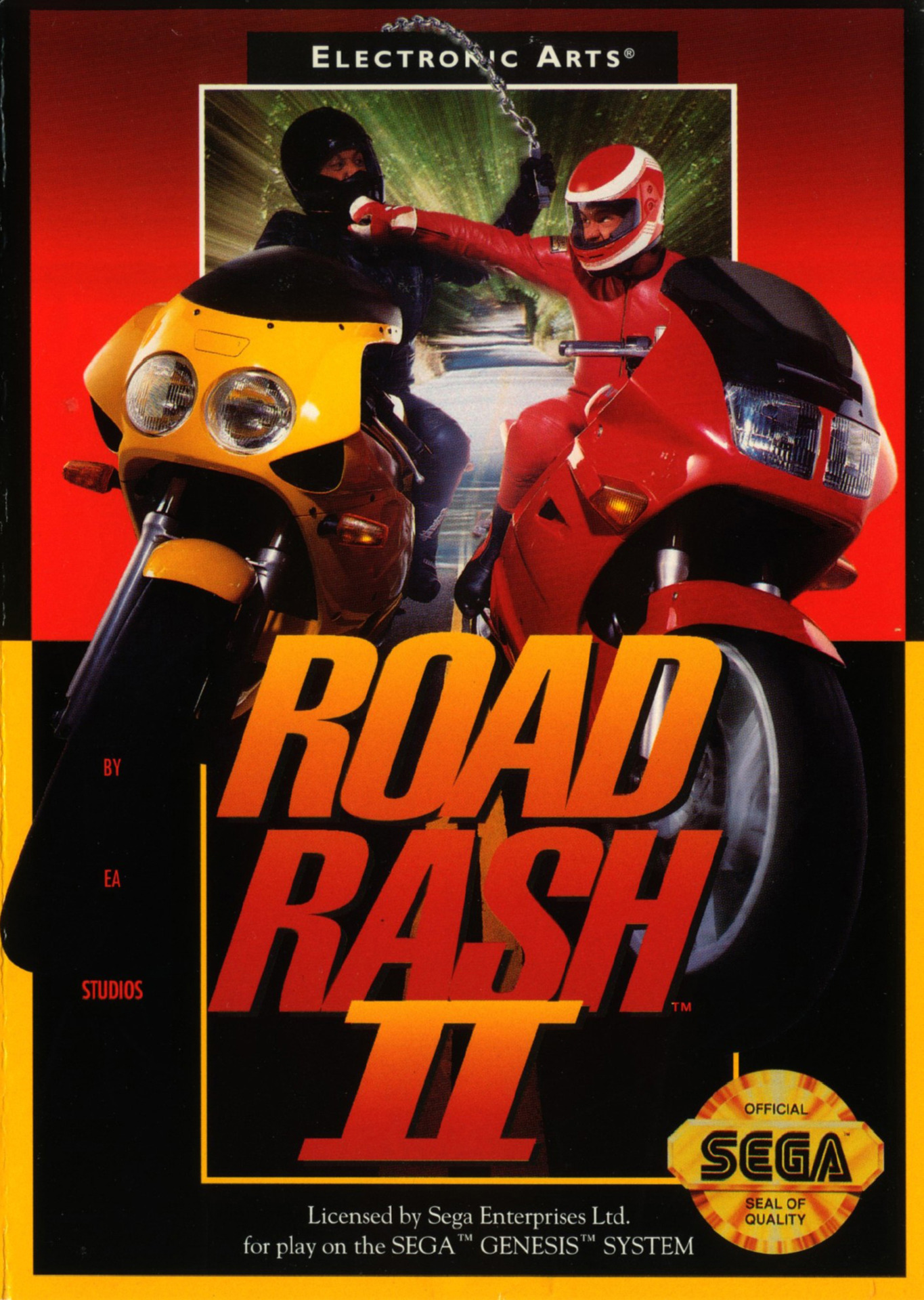
- Developer: Electronic Arts
- Publisher: Electronic Arts
- JP Release: 1993-07-23
- NA Release: December 1992
- EU Release: 1992-12-04
- Franchise: Road Rash
- Genre: Vehicular Combat
- Theme: Singlehandedly Keeping the Chain Whip Industry Alive
- Premise: Kickstart your bike and then start kicking other dudes off theirs in EA's biker brawler sequel, now exclusive to the Sega Genesis.
- Availability: It's made a few appearances since, first in the EA Replay PSP compilation and most recently on the Sega Genesis Mini.
- Preservation: There are many franchises that I associate closely with the Sega Genesis, even if they perhaps weren't exclusive to that platform, and EA's Road Rash is definitely one of them. Apparently I'm not alone if this sequel got itself added to the Sega Genesis Mini line-up. A response to the age-old proposition of "what if Hang-On but you could punch people?", Road Rash II polishes the concept introduced in the first game, allowing players to eventually upgrade to sturdier and faster bikes as they kept winning races. In true Streets of Rage style, every opponent has a name and a health bar if you felt like wasting time thinning out the field, or just focus on the ones with the more aggressive names and temperaments before they clobbered you first. The most important addition (besides the chain) is you could now hit the motorcycle cops that would sometimes tail you, escaping an early retirement from the race and a hefty fine, in a move that I'm sure had nobody up in arms about video game violence.
364: Deadly Moves

- Developer: System Vision
- Publisher: Kaneko
- JP Release: 1992-12-11 (as Power Athlete)
- NA Release: 1992 (as Deadly Moves)
- EU Release: N/A
- Franchise: N/A
- Genre: Fighter
- Theme: Jump Buttons in Fighter Games
- Premise: Joe intends to be the champion of champions but there's a long list of opponents to take down first, including a certain high-flying Hawaiian with a prominent underbite...
- Availability: The game's long out of print, but the curious can see it in action via this episode of Ranking of Fighters.
- Preservation: That's right, our old friend Warren is back. Well actually, he never left: Deadly Moves released around the same time as Power Moves for the SNES, and there's no significant differences beyond the name. Both versions are called Power Athlete in Japan, so whether the official name in the west was Deadly Moves until Nintendo balked and sanitized their version, or Sega of America subtly suggested the name to Kaneko to make their version seem more violent and edgy, is known only to the publishers. This is our first encounter with System Vision: this obscure Hokkaido-based developer primarily worked on fighters and the occasional fighter port, including a 1994 Genesis game slightly better than Deadly Moves (I won't spoil what it is, only that some samurai might have a shodown in it).
365: Nakajima Satoru Kanshuu F1 Super License

- Developer: Varie / Aprinet
- Publisher: Varie
- JP Release: 1992-12-11
- NA Release: N/A
- EU Release: N/A
- Franchise: Nakajima Satoru
- Genre: Racing
- Theme: Only Thing More Impenetrable than Formula One is Japanese Formula One
- Premise: Professional racer Nakajima Satoru is back one last time for this conclusion to a trilogy of F1 games from Varie, however this the first to actually have the F1 license.
- Availability: F1 won't even let the GB wiki use their logo, you'd think they'd let anyone rerelease old F1 games?
- Preservation: Oh look, another Drew game. We've been following this particular F1 series a while - the first was Nakajima Satoru Kanshuu F1 Grand Prix (MA XV) and the second was Nakajima Satoru Kanshuu F1 Hero MD released overseas as Ferrari Grand Prix Challenge (MA XVIII) - but I'm sad (eh...) to say this is the last of them. Satoru Nakajima, to refresh you all, was a mildly successful F1 racer overseas but something of an icon back home in Japan, where he blazed a trail for other Japanese racers to compete on the global stage (previously they'd been involved as engineers and designers). This was the first game in this series to be officially licensed by Formula One, but it seems it wasn't enough to keep this series going for much longer: as well as a SNES update of F1 Hero that launched the same month, it saw one more SNES sequel before the series ended. If you're looking for a serious Formula 1 simulation game with swimsuit anime girls in most of the menus, this might be the one for you.
366: World of Illusion Starring Mickey Mouse & Donald Duck
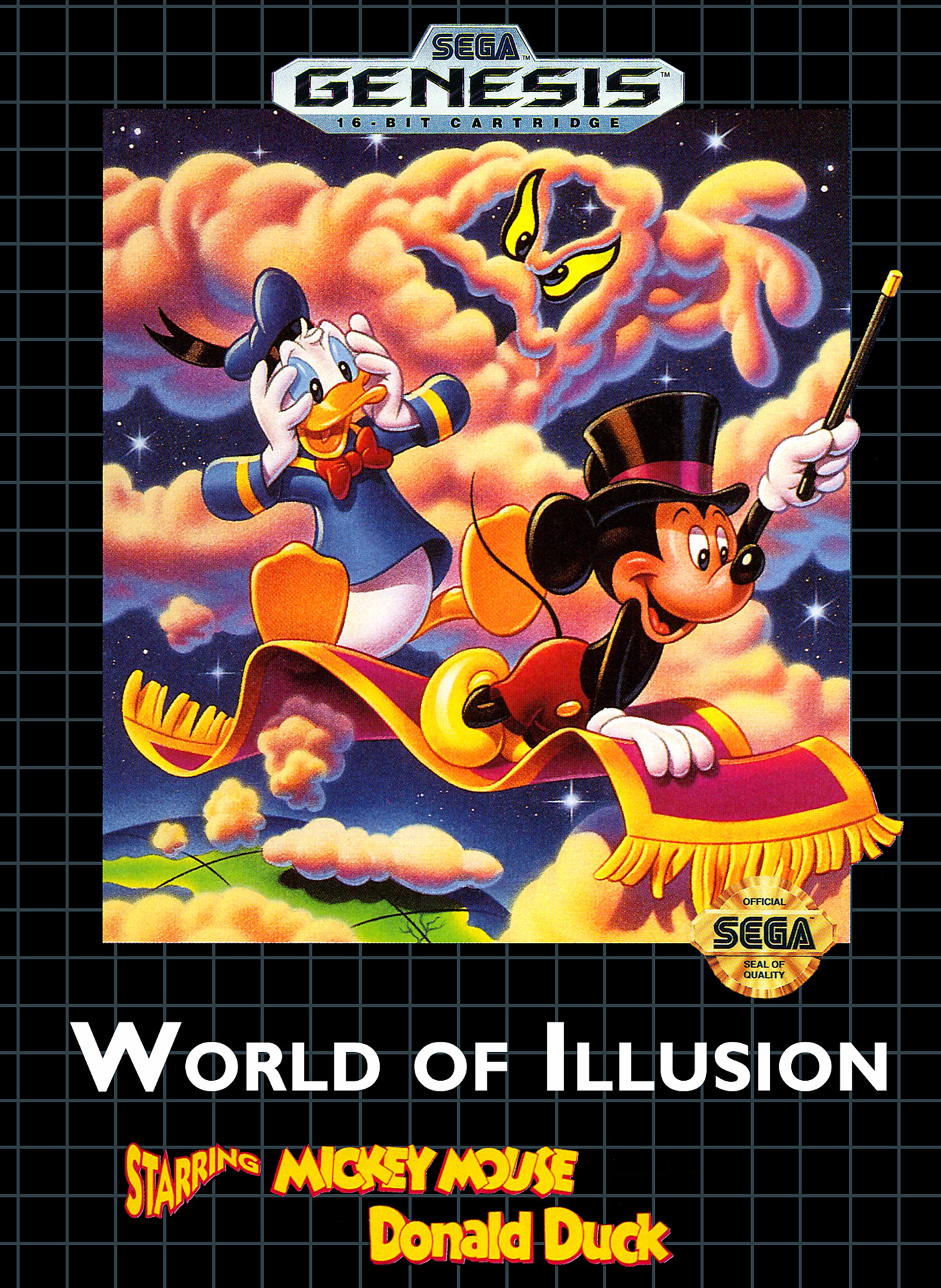
- Developer: Sega CS
- Publisher: Sega
- JP Release: 1992-12-18 (as I Love Mickey and Donald: Fushigi na Magic Box)
- NA Release: March 1993
- EU Release: 1992-12-14
- Franchise: Disney
- Genre: Platformer
- Theme: Known as Land of Illusion in California
- Premise: Mickey and Donald escape the castle of illusion only to fall into a world of illusion. Aren't all cartoons illusions though? Makes you think dot jpeg.
- Availability: World of Illusion is the second game this entry to have made it onto the Sega Genesis Mini.
- Preservation: Nostalgic Disney fans are usually drawn to the games based on movie licenses, Aladdin and The Lion King most of all, but for my money nothing tops the Mickey Mouse games from that period. The Illusion series was exclusive to Sega systems and are perhaps the best platformers you can get for the Genesis and Master System that aren't Sonic-related, at least in terms of their ingenuity and presentation. World of Illusion expands on what Castle of Illusion started, giving Mickey and Donald a co-operative adventure through various levels inspired by fairy tales and occasionally other Mickey Mouse/Donald Duck cartoons. The game noticeably builds its levels based around whether you have Mickey, Donald, or both: for example, Mickey is the only one who can squeeze through narrow gaps unassisted, so anyone tackling that level as just Donald will see slightly different level design to compensate. It's evident that despite all their edgy tough guy posturing, Sega took its relationship with Disney seriously if these were the caliber of games they were putting out on the cartoon corporation's behalf.
367: John Madden Football '93
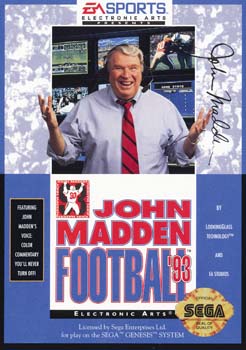
- Developer: Blue Sky Productions
- Publisher: Electronic Arts
- JP Release: N/A
- NA Release: December 1992
- EU Release: 1992-12-14
- Franchise: Madden NFL
- Genre: Football
- Theme: Football
- Premise: Football
- Availability: Madden NFL games are still coming out, just find a newer one.
- Preservation: December's the "end zone" of the year where the football season ends and the playoffs begin, so expect to see many football games charging towards it. In fact, we'll have three in the next episode, so that's something to look forward to (yaaaay). What's wild to me about this one is that it was developed by Blue Sky, but not the Blue Sky we've been bumping into with other football games like NFL Sports Talk Football '93 Starring Joe Montana (MA XXIV). No, this is the Blue Sky that would later become Looking Glass Studios: the creators of System Shock and Ultima Underworld and (after another name change) Deus Ex. Apparently, the cutting-edge tech they were using had caught the eye of EA's higher ups who were looking for a new studio to make the next Madden, and LGS found itself in the odd position of making Madden '93 and the first Ultima Underworld at the same time (because life is never fair, the former made way more cash for them than the latter, despite the latter being a huge milestone in the history of CRPGs). Despite still lacking the NFL license - Sega swept it up that year for the Joe Montana game I mentioned - this was one of the more successful entries in the franchise. LGS later claimed that EA began developing all subsequent Madden games in-house to avoid the significant amount of royalties they had to pay out to contract developers like themselves after Madden '93's high sales figures.
368: Lotus Turbo Challenge
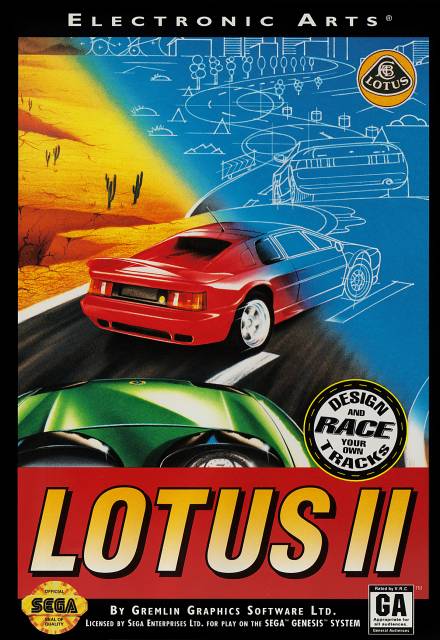
- Developer: Magnetic Fields
- Publisher: Electronic Arts
- JP Release: N/A
- NA Release: December 1992
- EU Release: 1992-12-14
- Franchise: Lotus
- Genre: Racing
- Theme: How Fast Can a Car Named After a Flower Move?
- Premise: The Lotus series comes to Sega Genesis with an all-new arcade feel. Can it compete with Sega's own OutRun though?
- Availability: Nothing more recent than a 1994 compilation for the CD32.
- Preservation: Lotus Turbo Challenge was more or less the racing franchise for Amiga (and Atari ST) owners - slick, attractive, and striking that fine balance between simulation and arcade to be realistic while also accessible enough to every level of player (as opposed to, say, the Test Drive franchise which was much more geared towards the simulation fans). It had pretty rad theme music too. Because this sequel was tweaked a little more towards the arcade set by changing the race format to the more familiar checkpoint-chasing of OutRun and the like, it saw itself getting a Genesis port courtesy of EA (previously, Gremlin Graphics had published the games on computers; it's unclear how much they were involved with the Genesis port, but it does credit them in the opening screens). Certain qualities had to be reduced a bit (including, sadly, the music) but it's a faithful enough port if perhaps a bit limited in size. Being built specifically for two-player splitscreen means a lot of wasted space in single-player too, though I guess you could argue that it's relaxing to have a calm blue sky taking up half the screen.
369: Risky Woods

- Developer: Dinamic Software, Zeus Software
- Publisher: Electronic Arts
- JP Release: 1993-02-19 (as Jashin Draxos)
- NA Release: December 1992 (as Risky Woods)
- EU Release: 1992-12-14 (as Risky Woods)
- Franchise: N/A
- Genre: Platformer
- Theme: Los Bosques Arriesgados Son Demasiado Arriesgados
- Premise: Save the good monks in this brutally tough platformer set in some risky woods. They're risky because of the danger, y'see.
- Availability: Unlikely to see a modern port, as Dinamic went bankrupt shortly after its release.
- Preservation: Couple new developers this time, Dinamic and Zeus. While I have no idea who Zeus were (contractors brought in to finish the Genesis port, is my guess), Dinamic is the first Spanish studio to snag themselves a Genesis release. Presently, Spain enjoys a moderately busy industry of Indie developers such as Pendulo Studios (Yesterday, Blacksad) and Tequila Works (Deadlight, The Sexy Brutale), but it was rare before then for any of its games to break out of its native land, let alone see the sort of global coverage that Risky Woods had with the help of distributors Electronic Arts. As to the game itself, Risky Woods is very much the typical "Amiga platformer": visually dense and impressive, though the gameplay errs towards the stupidly hard and generally unfair. To the latter point, you are regularly given items in treasure chests that penalize you in some way, and they're indistinguishable from the good. Likewise, your goal is to rescue a bunch of monks imprisoned in stone, but some of them are actually hostile and seemingly placed there to troll you. It's evident that there's a lot of Ghosts 'n Goblins DNA in here (your main weapons are projectiles that can be replaced or upgraded, and with enough perseverance you can earn yourself some protective armor), and between these traps and endlessly respawning flying enemies they certainly got the "Why am I putting myself through this?" vibe right.
370: Ex-Mutants
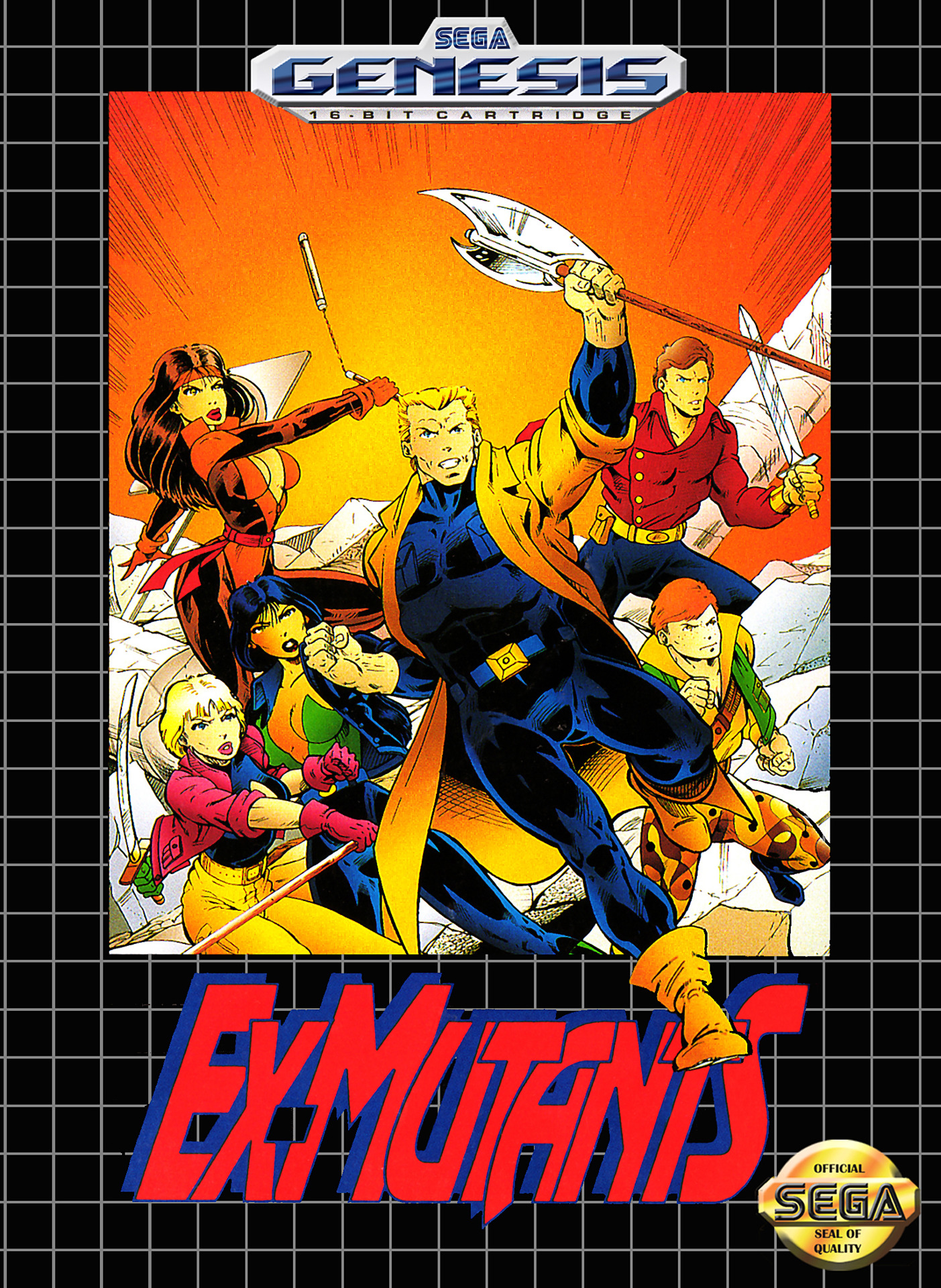
- Developer: Malibu Interactive
- Publisher: Sega
- JP Release: N/A
- NA Release: December 1992
- EU Release: 1992-12-18
- Franchise: N/A
- Genre: Platformer
- Theme: The Three Cornerstones of Any '90s Comic Series - Swords, Boobs, and Saving the Environment
- Premise: The Ex-Mutants, a superhero group restored back to humanity by the genius Prof. Kildare, must defeat Sluggo if they're going to save the post-apocalypse.
- Availability: There's been nothing Ex-Mutants-related produced since 1994. Marvel owns the IP though, so maybe if the MCU's really struggling for new teams...
- Preservation: I don't spend a whole lot of time over on our sister site Comic Vine, so I'd never heard of the Ex-Mutants before. Seem to be part of a wave of superhero team comics like Youngblood where all the members were teens with attitude who had ninja weapons and cussed a whole lot. I dunno, that whole period of the 1990s is frequently a sore spot for any serious comic book fans but I can't say I was all that invested in the industry at the time beyond the X-Men and Batman cartoons. The Ex-Mutants, not to be confused with the X-Mutants though I'm sure that was intentional, are survivors of the post-apocalypse restored back to human forms by a benevolent cyborg scientist that looks like a Terminator and were given the roles of being the only attractive people left in the world, which naturally drew in a lot of antagonism from weird slug monsters like the game's villain Sluggo (not the one from the Nancy comics, I made sure to check). It plays much like Risky Woods, above, with platforming and projectile-based attacks and a whole lot of traps and other hazards. It does play a little better than most of the superhero games from that era though, the reason being that Malibu Comics bought their own game development studio (Acme Interactive, who we've met a few times before with sports games like David Robinson's Supreme Court and Cal Ripkin Jr. Baseball (both MA XVIII)) to turn one of their own IPs into a video game. It must've sold well enough because Malibu Interactive went on to make several more games for the Genesis and SNES, usually featuring superheroes that weren't theirs. Ah well.

0 Comments